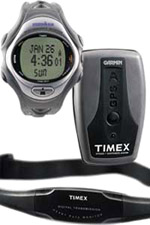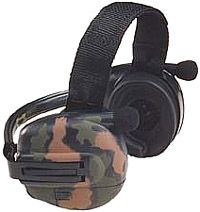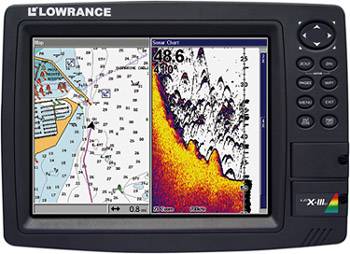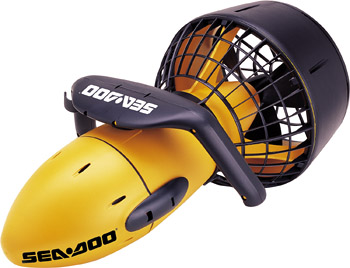HOW TO BECOME THE ULTIMATE HIGH-TECH ADVENTURER
All About GPSBack in Part 4, "The Ultimate High-Tech Car Owner," I first talked about GPS navigation systems. It's an especially useful technology for finding your way when driving, but it's also quite popular among outdoor adventurers. The technology is a tad complex, originally developed for military use, but it's definitely filtered down to the level of the average consumer in terms of both usability and price. Today you can purchase a decent handheld GPS unit for less than $200 and get the same type of performance that our soldiers do in the field. You can also spend a lot more than $200, especially if you like lots of gee-whiz features. Spend more money and you get a more compact unit (it costs big bucks to make things smaller), a color display, and more creature comforts, in the form of automatic route generation, more programmed points of interest, more storage capacity, and so on. Some higher-end units also claim increased accuracy, by using more satellites to gauge position. (The typical unit tracks up to 12 satellites at a time; some track a few more.) In any case, expect accuracy in the three-meter range, which isn't shabby. As with in-car GPS units, there are certain features you want to look for when shopping for handheld units. In particular, you want to be sure the unit comes with the base maps you need for where you'll be using it. (In other words, don't buy a European unit if you're trekking in the Sierra Nevadas.) You also want to see how many different routes the unit can store in memory; the more stored routes, the better. In addition, check the number of waypoints it can store, both in total and per route; a unit that holds 50 waypoints per route is more versatile than one that holds only 25 waypoints per route. While many adventurers are happy with general handheld GPS units that they can use across a number of different activities, you also have the choice of activity-specific units. That is, there are GPS units targeted specifically at campers and hikers, at hunters, at runners, at boaters, and so on. These sport-specific units typically come with customized maps and databases, and often offer other features of interest to a particular type of activity. For example, a GPS unit for hunters might include a built-in compass and onscreen icons to track hunting stands and such; a unit for runners might include a chronometer and lap counter. You get the picture. Whichever type of unit you choose (general or sports-specific), make sure you like the look and feel of the device. Pay particular attention to the display; is it easily viewable in all weather conditions? Is the device light enough and compact enough to carry around all day? Does it feel good in your hand; does it come with a carrying case or strap? And, depending on your activity, is it water resistant or waterproof? All these things are important, as is battery life; you don't want your GPS device dying on you when you're out in the middle of nowhere! Gadgets for RunnersLike all sports, running has become particularly high-tech in recent years. From the simple pedometer to the complete performance monitoring systems, computers are being put to good use to help you track and monitor your activities and performance. At the high end, performance monitoring systems incorporate GPS receivers to help track your location, distance traveled, pace, speed, and so on. You'll also get separate heart monitors, which are typically worn around your chest; signals are transmitted from the heart monitor to the main unit via wireless technology. You can set a target heart rate and get an alert if you go beyond it. Most high-end performance monitoring systems also let you transfer the collected data to your PC, either via USB, infrared, or RF signals. You can then upload the data to performance-tracking software and generate all manner of graphs and reports. It's a cool way to track and analyze your performance over time. When shopping for a performance monitoring system of any sort, probably the most important factor is size. You don't want to be weighted down by a bulky monitor and display; you want something small and sleek and lightweight. Some systems are incorporated into sports watches, which is nice. Others come in separate units that you can clip to your belt or wear on an armband. Whichever type of system you choose, make sure it's something you'll be comfortable with during a long run.
Gadgets for CampersObviously, one of the most essential gadgets for campers is a handheld GPS device. You don't need anything fancy, just something to tell you where you are when all you can see are trees and rocks. That's not to say that extra features aren't useful; I particularly like those units with a built-in electronic compass, altimeter, and the like. The more info the better, I say! Speaking of info, for those long hikes it's nice to know what to expect of the weather. To that end, consider a portable weather tracker. The best of these provide dozens (if not hundreds) of measurements, from temperature and humidity to wind chill and dew point. Most units come with built-in thermometers and barometers, as well as little fan-like thingies to measure wind speed. Make sure the unit is small enough to carry comfortably, of course. Other useful gadgets for campers tend to fall into the creature comforts category. By this I mean backpacks, coolers, water carriers, and the like. There are even portable ice cream and espresso makers designed especially for use out in the wild. Heck, take along your cell phone, PDA, and portable video player, and it's like you've never left home! Gadgets for HuntersGPS devices are especially useful for hunters, considering their ability to store important track points. Once you locate a good location, just program it into the device, and you'll be able to find the spot again when you come back next year. (Plus, and this goes without saying, you stand a much lower chance of getting totally lost, which is always a major embarrassment.) But that's not the only way that high-tech gadgets can improve your hunting experience. I especially like electronic viewing and listening aids, such as night-vision viewers and amplified headphones. I know it sounds a little Six Million Dollar Man-like, but augmenting your senses electronically makes a lot of sense when you're in a hostile environment. (Okay, so your local woods isn't all that hostile, but you know what I mean.) Plus, it's kind of cool to be able to see in the dark and hear raccoons whispering from a hundred yards away. (Do raccoons whisper? I don't know…)
Technology can also be used to attract your prey. I'm particularly intrigued by robotic decoys, like the RoboDuk, that are kind of creepy yet fascinating, all at the same time. Also interesting is the computerized take on the old-fashioned animal call, with dozens of different calls digitized for extremely accurate reproduction in the wild. It sure beats trying to do all those calls yourself! Gadgets for FishermenFishing used to be a relaxing sport. You bait your hook, drop your line, then settle back with a cold beer and a hat over your eyes. (The cold beer isn't over your eyes; the hat is.) Today, however, there are all sorts of high-tech devices that make fishing more like hunting, an active activity rather than a passive one. First off, consider the concept of the fishfinder. This is a device that uses sonar technology to beam back electronic images of underwater life, so you can see onscreen whether there are any fish nearby. Extremely high-tech and extremely practical, a good fishfinder will keep you from wasting time fishing where the fishes aren't. If sonar is good, why not utilize an underwater camera to actually see any fish that are nearby? It's doable, thanks to today's miniaturized and ruggedized video cameras. Just drop a special fishcam off the side of your boat, and watch the show on an attached LCD monitor. Low-light technology ensures that you can actually see through the murky depths although not as far as you can with sonar. (That's why the best bet is to use a combination of video and sonar technology.) Finally, we have the option of trying to attract the fish, not just look around and see if they're nearby. To that end, consider a submersible fish light, which uses a special colored bulb to make fish think that there's a full moon out. Fish are attracted to the light, which makes them easy prey. Once again, technology delivers! Gadgets for BoatersIf you like fishing technology, you'll love boating technology. (Of course, for many adventurers fishing and boating go hand-in-hand.) For the high-tech boater there's no end of expensive gadgets to invest in. First off is a GPS device specialized for boating use, called a chartplotter. A chartplotter is like a traditional GPS but with detailed maps of waterways rather than roadways. If you're navigating any large expanse of water from the Great Lakes to the Atlantic ocean one of these devices is essential for determining exactly where you are at any given point in time. As with any GPS device, you want to look for highly detailed maps and lots of storage for different routes and trackpoints. What gets fun is combining a chartplotter with other technology. Here you have two different ways to go. The first combines the chartplotter with a sonar device, so you can track your progress underwater as well as on the waves. (It's also great for fishing!) The other option combines the chartplotter with a radar transmitter, so you can track oncoming weather while you're on the water. The best of these units function much like the professional units used by your local TV weatherperson, with color displays for various levels of precipitation and such. If you go with one of these combo devices, pay particular attention to the display screen. The more data you display, the bigger the screen you want. Some of these displays go to 10'' or more and are designed for use in both shade and direct sunlight. A bigger screen lets you display two types of info side-by-side GPS chart and sonar map, for example, or GPS map and radar screen. Even better, some units let you superimpose one type of map on top of the other. Trust me, it's extremely useful to see your normal map with radar conditions overlaid on top.
The whole point of all these marine electronics is to keep you on course and away from dangerous conditions on, under, or above the water. Sure, some of these gizmos are a little expensive, but you can't put a price tag on your safety, especially when you're out on the open water. When all you can see with the naked eye is a horizon full of wet, you need high-tech help to get to where you want to go, safely. Gadgets for Scuba DiversI'm not a scuba diver myself, but I know some guys who are, and I really think it's a fun sport not just for what you do while underwater, but for all the cool gear you get to buy. Scuba diving has long been a high-tech sport, and it keeps getting more high-tech as time goes on. The first high-tech device for any serious diver is the dive computer. This is a gizmo that measures depth, time, temperature, ascent/descent rate, and the like, and calculates how much time you have left on your oxygen tank, when you need to ascend (and how quickly), and so on. Newer technology is helping to miniaturize the traditional dive computer, to the point that you can now get a dive computer on a wrist watch. This tech is so cool it tempts me to take scuba lessons myself! There's also the issue of how you get around while you're underwater. If you remember the James Bond movie Thunderball, you recall how 007 jetted from place to place using an underwater jetpack of sorts, which was extremely cool. Well, underwater jetpacks haven't quite come into the mainstream, but the concept of an underwater propulsion device has become viable. I'm talking about a small propeller-driven gadget that you hold onto with both hands and let it drag you behind it. You only go a couple of miles an hour, but that's a couple of miles an hour faster than you can manage with a pair of flippers. It's actually quite cool, and a lot of fun.
But these two types of gadgets just scratch the surface. There's a lot more out there for the high-tech diver, as well as for high-tech adventurers of all sorts. Read on to see some of the most useful and most fun gadgets available and don't forget to check at your local sporting goods store for even more! |
EAN: 2147483647
Pages: 126
- Chapter VI Web Site Quality and Usability in E-Commerce
- Chapter XI User Satisfaction with Web Portals: An Empirical Study
- Chapter XIII Shopping Agent Web Sites: A Comparative Shopping Environment
- Chapter XV Customer Trust in Online Commerce
- Chapter XVIII Web Systems Design, Litigation, and Online Consumer Behavior



